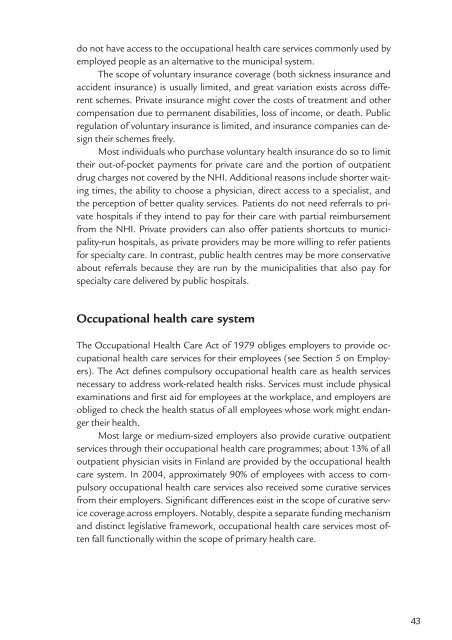The Finnish Health Care System - Institute for Strategy and ...
The Finnish Health Care System - Institute for Strategy and ...
The Finnish Health Care System - Institute for Strategy and ...
- No tags were found...
Create successful ePaper yourself
Turn your PDF publications into a flip-book with our unique Google optimized e-Paper software.
do not have access to the occupational health care services commonly used byemployed people as an alternative to the municipal system.<strong>The</strong> scope of voluntary insurance coverage (both sickness insurance <strong>and</strong>accident insurance) is usually limited, <strong>and</strong> great variation exists across differentschemes. Private insurance might cover the costs of treatment <strong>and</strong> othercompensation due to permanent disabilities, loss of income, or death. Publicregulation of voluntary insurance is limited, <strong>and</strong> insurance companies can designtheir schemes freely.Most individuals who purchase voluntary health insurance do so to limittheir out-of-pocket payments <strong>for</strong> private care <strong>and</strong> the portion of outpatientdrug charges not covered by the NHI. Additional reasons include shorter waitingtimes, the ability to choose a physician, direct access to a specialist, <strong>and</strong>the perception of better quality services. Patients do not need referrals to privatehospitals if they intend to pay <strong>for</strong> their care with partial reimbursementfrom the NHI. Private providers can also offer patients shortcuts to municipality-runhospitals, as private providers may be more willing to refer patients<strong>for</strong> specialty care. In contrast, public health centres may be more conservativeabout referrals because they are run by the municipalities that also pay <strong>for</strong>specialty care delivered by public hospitals.Occupational health care system<strong>The</strong> Occupational <strong>Health</strong> <strong>Care</strong> Act of 1979 obliges employers to provide occupationalhealth care services <strong>for</strong> their employees (see Section 5 on Employers).<strong>The</strong> Act defines compulsory occupational health care as health servicesnecessary to address work-related health risks. Services must include physicalexaminations <strong>and</strong> first aid <strong>for</strong> employees at the workplace, <strong>and</strong> employers areobliged to check the health status of all employees whose work might endangertheir health.Most large or medium-sized employers also provide curative outpatientservices through their occupational health care programmes; about 13% of alloutpatient physician visits in Finl<strong>and</strong> are provided by the occupational healthcare system. In 2004, approximately 90% of employees with access to compulsoryoccupational health care services also received some curative servicesfrom their employers. Significant differences exist in the scope of curative servicecoverage across employers. Notably, despite a separate funding mechanism<strong>and</strong> distinct legislative framework, occupational health care services most oftenfall functionally within the scope of primary health care.43
















